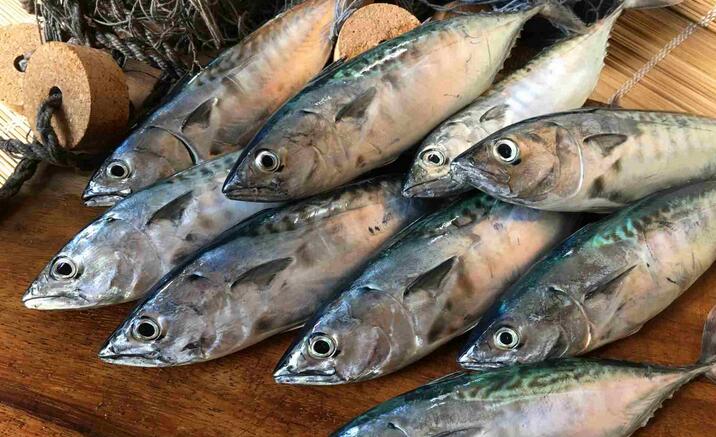Tuna is a fish that many dog owners have considered feeding to their pets. It’s a good source of protein, omega-3 fatty acids, and various vitamins and minerals that can benefit dogs. However, tuna also contains mercury and lacks some nutrients dogs need to stay healthy. So can dogs eat tuna safely?
While tuna can make an occasional tasty treat, there are some risks to be aware of with feeding too much tuna to dogs regularly or long-term. This comprehensive article will cover the potential benefits and risks of tuna for dogs, how much tuna dogs can eat, and tips for safe tuna feeding.
Can Dogs Eat Tuna?
Dogs can eat small amounts of tuna occasionally as a treat, but it should not be a regular part of their diet.
The main risks of feeding tuna to dogs are potential mercury poisoning and nutritional imbalance. Tuna contains higher levels of mercury than many other types of fish.
Consuming high amounts over time can cause mercury to accumulate in a dog’s body. This can be toxic to dogs. It may lead to severe symptoms like tremors, vomiting, and kidney damage. Even death is possible in extreme cases of mercury toxicity.
Additionally, tuna lacks certain nutrients like calcium that dogs need for balanced nutrition. Relying on tuna as a staple could lead to deficiencies. Eating too much can also lead to several negative health consequences, including obesity, digestive issues Nutrient toxicity, etc.
So while the omega-3s and protein in tuna can benefit dogs, the mercury levels make regular consumption too risky. Limit tuna feeding to no more than once a month in very small amounts such as 1-2 ounces for a large dog.
Also choose fresh tuna and low-sodium, water-packed tuna. Tuna should only be an occasional treat in strict moderation for dogs.
Nutrient Fact of Tuna For Dogs
Here is a table summarizing some of the key nutrients found in a 3 oz serving of tuna:
| Nutrient | Amount | % Daily Value | Benefits |
|---|---|---|---|
| Protein | 22-26 g | 44-52% | Growth/development, hormones, immunity |
| Omega-3s | 500-1000 mg | N/A | Anti-inflammatory, heart health, brain/eye support |
| Vitamin D | 150 IU | 50% | Bone health, calcium absorption |
| Vitamin B12 | 2.5 mcg | 175% | Red blood cell production, DNA synthesis |
| Selenium | 111 mcg | 160% | Thyroid function, antioxidant |
| Niacin | 20 mg | 100% | Energy metabolism, nerve function |
| Potassium | 300 mg | 8% | Fluid balance, muscle function |
| Vitamin B6 | 0.5 mg | 30% | Enzyme reactions, metabolism |
As shown in the table, tuna is high in protein, omega-3 fatty acids, vitamin B12, selenium, and other B vitamins compared to daily nutritional requirements. The levels make it one of the more nutrient-dense fish, offering a range of health benefits.
Potential Benefits of Tuna for Dogs
Here is more detail on some of the potential benefits of tuna for dogs.
1. High Protein Content
As mentioned, tuna provides a dense source of complete, high-quality protein. This protein gives dogs’ bodies the amino acid building blocks needed for:
- Growth and maintenance of muscles, organs, enzymes, hormones
- Function of the brain, heart, kidneys, and other systems
- Skin and coat health
- A properly functioning immune system to fight off illness and infection
The table below shows the crude protein comparison of tuna vs. minimum AAFCO requirements for adult dog foods and puppy foods:
| Food | Crude Protein |
|---|---|
| Tuna | 22% |
| AAFCO Adult Minimum | 18% |
| AAFCO Puppy Minimum | 22% |
As you can see, tuna meets and exceeds the minimum protein requirements set for both adult and growing puppy dogs.
Some dogs have particularly high protein demands, including:
- Puppies – for proper growth and development
- Pregnant/nursing dogs – to nourish developing fetuses and milk supply
- Working dogs – sled dogs, hunting dogs, herding breeds, etc.
- Dogs with cancer – to prevent cachexia/muscle wasting
For these dogs, supplementing their diet with the extra protein from tuna can help provide support that exceeds what commercial dog foods contain.
2. Omega-3 Fatty Acids
The omega-3 fatty acids in tuna provide dogs with the same anti-inflammatory, heart-healthy, and brain/eye benefits they give humans.
Some health benefits of EPA and DHA for dogs include:
- Shiny coats – omega-3s nourish skin and fur oils
- Healthy joints – reduces inflammation causing arthritis pain
- Supports cognition and memory, especially in senior dogs
- Fights heart disease – omega-3s keep hearts healthy long-term
Omega-3s also play a crucial role in dogs’ central nervous systems, eye development, immune response, and cell membrane function.
Many commercial dog foods provide omega-3s from plant sources like flax. However, the DHA/EPA in marine sources like tuna provide more potent, bioavailable forms.
So tuna can give an extra omega-3 boost above typical dog food levels.
3. Vitamins and Minerals
As covered earlier, tuna contains B vitamins, selenium, phosphorous, and other beneficial vitamins and minerals. Getting these micronutrients from whole food sources allows for proper absorption and utilization in the body.
Tuna’s natural vitamins/minerals support various processes like:
- Bone health – calcium, phosphorous, vitamin D
- Making enzymes, hormones, and neurotransmitters – B vitamins, selenium
- Fighting oxidative damage – selenium, vitamin E
- Metabolism and thyroid function– iodine, B vitamins
- Hemoglobin production – B12, iron
- Muscle and nerve conduction – potassium, choline
So tuna can provide a spectrum of micronutrients to complement those already in complete dog foods.

Risks and Downsides of Feeding Dogs Tuna
However, there are also some important risks and downsides to be aware of when it comes to feeding tuna to dogs, especially on a regular or excessive basis.
1. Too Much Mercury
One of the biggest risks pet owners should be aware of is mercury exposure from tuna. Like many large, predatory fish, tuna bioaccumulates methylmercury within its tissues over its long lifespan.
When dogs eat tuna, they ingest this organic mercury compound. Over time, the accumulation of mercury can cause mercury poisoning.
Mercury poisoning is very serious and sometimes irreversible once neurological symptoms develop.
2. Signs of Mercury Poisoning in Dogs
There are several potential signs of mercury poisoning to watch for in dogs. Early symptoms may be subtle but can become severe if dogs consume high mercury levels over time.
Some neurological signs of mercury toxicity include tremors or lack of coordination, anxiety, blindness, seizures, and even coma or death in extreme cases. Digestive issues like vomiting, diarrhea, or bloody stool could also indicate mercury poisoning.
Kidney damage is another symptom, which can cause dogs to have trouble urinating or lead to swelling in the abdomen. Skin irritation, itching, hair loss, or skin lesions may also develop from mercury exposure according to the sources.
Since dogs don’t show symptoms until weeks or months after ingesting mercury, it can be difficult to diagnose. But if a dog exhibits any combination of these neurological, gastrointestinal, kidney or skin symptoms, mercury poisoning should be considered.
3. Lack of Balance
While tuna itself contains beneficial nutrients, it does not contain all the necessary vitamins, minerals, and nutrients required in a dog’s diet in the right proportions.
As a single ingredient, tuna lacks crucial nutrients like:
- Calcium
- Iron
- Copper
- Manganese
- Iodine
- Vitamin E
- Vitamin C
- Sufficient vitamin A levels
Without a steady intake of all these nutrients in balance, dogs can develop deficiencies over time negatively impacting their health.
Commercial complete and balanced dog foods meet AAFCO Dog Food Nutrient Profiles, unlike single ingredients like tuna. They blend animal proteins, fats, carbohydrate sources, and micronutrients in optimal ratios to give dogs all the nutrition they require.
4. High Sodium Content
The canning process for tuna utilizes quite a bit of sodium and salt to help preserve shelf life. Just a 3 oz can of tuna can provide over 350 mg of sodium – far above the maximum AAFCO recommendation for adult dogs:
| Sodium mg/100 kcal | 3 oz (85g) Can | |
|---|---|---|
| Tuna | 180 mg | About 350 mg |
| AAFCO Max | 69 mg | N/A |
Consuming very high sodium levels can cause issues like:
- Increased thirst and urination
- Vomiting/regurgitation
- Diarrhea
- Abdominal pain/bloating
- Even sodium ion poisoning in extreme excess
Dogs with pre-existing health conditions like pancreatitis, kidney/liver disease, congestive heart failure, hypertension, or sodium ion sensitivity face higher risks. The sodium load from tuna can exacerbate these issues.
For healthy dogs, minimizing tuna intake is key to avoiding adverse effects from excess sodium.
5. Allergies and Intolerances
Finally, some dogs may have allergies or intolerances to tuna itself or additives like onions, garlic or preservatives added during manufacturing and canning.
Possible reactions could include:
- Itching, inflamed skin or ear infections
- Hives
- Gas
- Loose stool/diarrhea
- Vomiting
It’s important to watch your dog’s reaction very closely whenever feeding any new food, including tuna. Stop feeding immediately if any symptoms develop and consult your veterinarian.
How Much Tuna Can Dogs Eat Safely?
Due to the potential risks covered above, tuna should only be fed to dogs in strict moderation if owners choose to feed it at all. Here are some guidelines on safe tuna consumption limits for dogs:
- Tuna should only be an occasional treat – not a regular part of their diet
- Limit tuna feeding to no more than once a week
- A maximum of 1 to 3 oz of tuna 1 to 3 times a month is a safer guideline for limiting mercury exposure
- For small dogs under 20 lbs, never exceed 1 oz
- For medium dogs 20 – 50 lbs, 1 – 2 oz
- For large dogs 50 – 90 lbs, 2 – 3 oz
- For giant breed dogs over 90 lbs, 3 oz
These conservative tuna feeding guidelines allow dogs to safely enjoy tuna in strict moderation as an infrequent fishy snack.
Of course, dogs with health conditions may need to avoid tuna altogether. Checking with your veterinarian is advised before incorporating any new food.
Tips for Safely Feeding Tuna to Dogs
If you do choose to occasionally feed your dog tuna as a special treat, here are some tips to reduce risks:
- Choose tuna canned in water instead of oil
- Look for low-sodium or no salt added tuna
- Rinse the tuna before feeding to further reduce sodium content
- Avoid flavored/spiced/marinated tuna or tuna packed with onions, garlic, etc.
- Thoroughly cook tuna before feeding – do not feed raw
- Mix with other foods so tuna does not exceed 10% of the total diet
- Balance with calcium-rich foods like dairy, dark greens, etc. to make up for calcium deficiency
- Monitor reactions closely – stop feeding immediately if any symptoms develop
- Get guidance from your vet if your dog has health conditions or known intolerances before feeding tuna
Following these tips and maximum intake guidelines can allow tuna to be fed safely.
Signs of Tuna Overdose or Allergy
It’s crucial to monitor your dog closely whenever feeding any new food, including tuna. Stop feeding tuna right away and contact your vet if you notice any of these signs:
- Loose stool, vomiting, diarrhea
- Increased thirst and urination
- Red, itchy skin or ear infections
- Hives, swollen face/muzzle
- Loss of coordination, seizures, tremors
- Lethargy/lack of energy
These can indicate possible mercury toxicity, sodium overdose, allergies, or nutritional imbalance from tuna over-consumption. Timely veterinary care is vital if any symptoms present.

What Other Fish Can Dogs Eat?
While tuna can be an option in moderation, some healthier fish alternatives to try instead include:
- Salmon – Salmon is a great source of omega-3 fatty acids for skin/coat health. Look for wild-caught Pacific salmon.
- Cod – Cod is a white, flaky fish that is low in fat and mercury. It offers lean protein.
- Pollock – Pollock is another whitefish similar to cod with low mercury levels. It provides B vitamins.
- Tilapia – Tilapia is a widely available freshwater fish. It contains vitamin D and selenium.
- Catfish – Farm-raised catfish contains vitamin B12, omega-3s, and antioxidants when fed a natural diet.
- Sardines – Sardines are small, oily fish high in omega-3s. Look for varieties packed in water.
The key when choosing fish for dogs is to avoid high mercury varieties like tuna, swordfish, mackerel, and shark. Lean white fish low in mercury are the healthiest to incorporate into a dog’s diet in moderation. Try to choose raw fish and cook fish fully before feeding.
How to serve tuna to your dog?
If you do decide to share tuna with your dog, follow these best practices for a safe introduction:
- Start with just a small bite to test the initial tolerance
- Choose a day when you are home to monitor reactions for at least 8 hours
- Mix thoroughly with their regular dog food instead of offering plain
- Feed at the start of a meal, not on an empty stomach which can trigger digestive upset
- Wait 5-7 days between introductions of any new food, including tuna
- Keep a food journal noting any symptoms that develop like itching, vomiting, diarrhea etc.
- Avoid other rich/fatty foods on days when feeding tuna
Taking things slowly allows your dog’s digestive system to adjust to this fishy, salty new protein source. Wait until at least 1 year old for large breed puppies per veterinary guidelines.
If any symptoms present at any point, stop feeding tuna immediately. Notify your veterinarian if symptoms are severe or persist beyond 24 hours.
Other Tuna-Related Questions
Here is some more in-depth information answering some common questions dog owners have about feeding tuna:
1. Can puppies have tuna?
Tuna is not recommended for puppies under 1 year old by veterinary guidelines. Growing puppies requires balanced nutrition not found in single ingredients like tuna.
Puppies also have developing digestive systems that are more prone to upset. Overloading of protein, fat, sodium, or minerals can be problematic.
Lastly, mercury exposure poses higher risks to developing puppies. It’s best to wait until at least 1 year old as their digestive and immune systems mature before trying small tuna introductions.
2. Can dogs eat raw tuna?
Feeding raw tuna is not recommended for dogs. As mentioned, raw tuna may contain parasites like tapeworms, nematodes, or flukes that can infect dogs if consumed.
Additionally, raw tuna’s thiaminase enzyme destroys vitamin B1 levels. Over time, this can lead to neurological issues and seizures. Lastly, raw tuna provides an extra heavy load of mercury versus cooked tuna, increasing toxicity risks.
3. Is canned tuna bad for dogs?
Canned tuna itself is not inherently “bad” for dogs, though it does come with some risks as covered earlier. The main concerns with canned tuna include:
- High sodium levels – can cause upset stomach, dehydration, electrolyte imbalance
- Mercury exposure over time
- Missing nutrients like calcium and anti-oxidants
- Allergies/intolerances to tuna or additives
As long as serving sizes are limited to occasional small treats, most healthy dogs tolerate canned tuna just fine. Strict moderation is key, along with buying low-sodium varieties.
4. Can dogs eat tuna every day?
It is not recommended to feed tuna every day, or even every week. Due to the mercury and nutritional balance risks, tuna should only be an occasional treat in limited amounts.
Feeding tuna daily over extended periods allows for mercury build-up in the body while missing out on other crucial nutrients not found in tuna.
Limit tuna feeding to once a month maximum to avoid elevated mercury levels or deficiency symptoms. If feeding more often than that, substitute some feedings with healthier lean fish options lower in mercury.
5. Is canned tuna good for dogs?
Based on the search results, canned tuna can be good for dogs in moderation. However, there are also risks to feeding canned tuna to dogs:
- Potential for mercury exposure and poisoning over time
- Often contains high levels of sodium which can cause dehydration, vomiting, diarrhea
- Lacks balanced nutrition on its own, unlike complete commercial dog foods
So while canned tuna can offer supplemental nutrition, it should only be fed occasionally and in strict moderation. Guidelines are to limit canned tuna to no more than once a week and adjust serving sizes based on the dog’s size. Additionally, choosing low-sodium and water-packed tuna helps reduce risks when feeding dogs.





